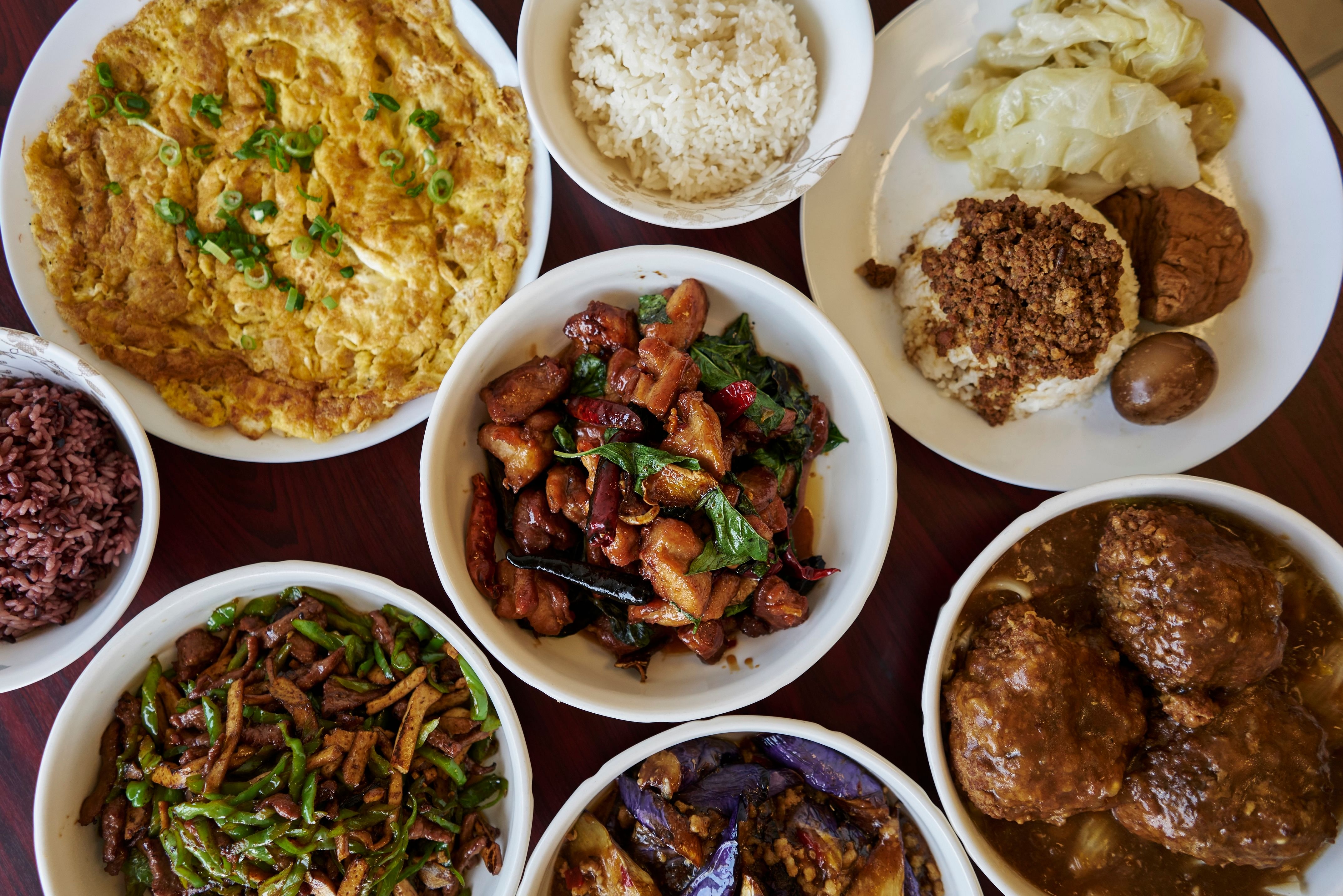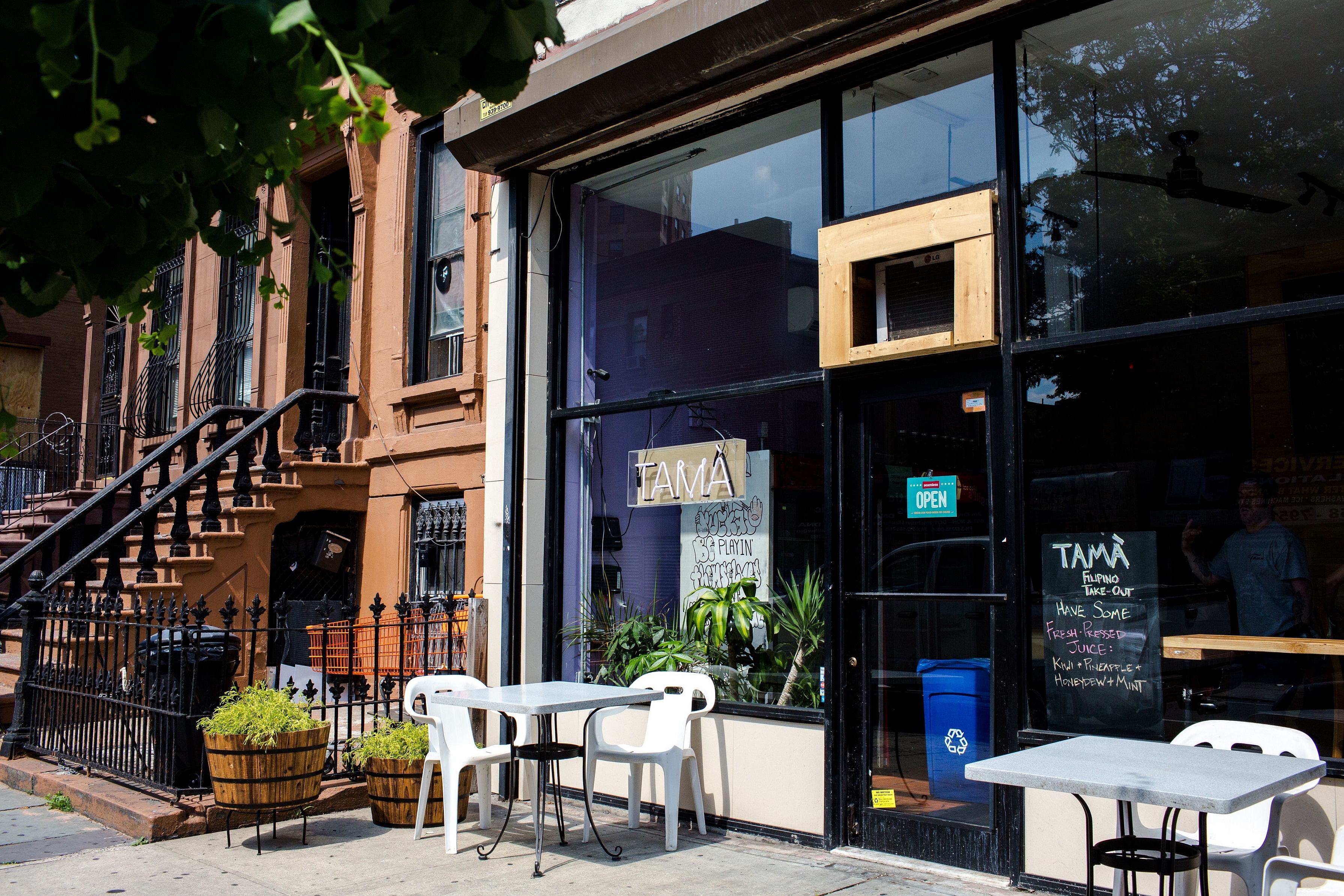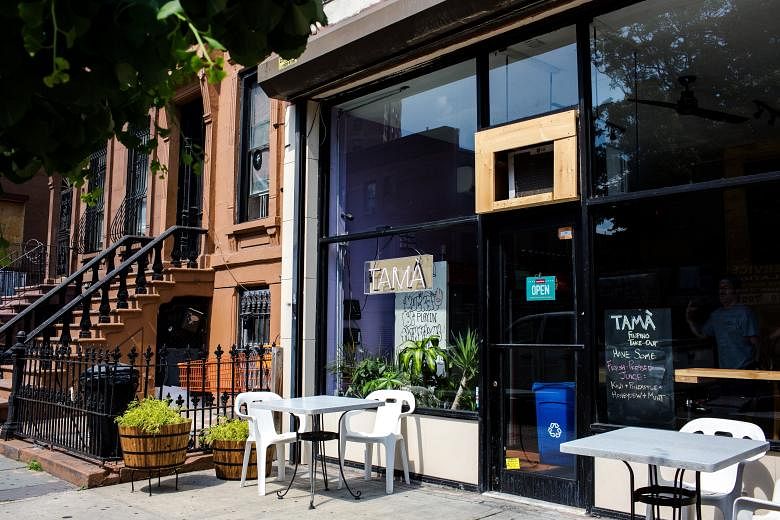NEW YORK (NYTIMES) - The places to eat that I like best are imperfect. They might have unsteady tables and bony chairs, set too close together, and doors that don't shut properly, letting in every hiss of wind.
They might keep erratic hours, close early without warning and never answer the phone. A dish might touch heaven on one visit and fall to earth the next.
What they give me is something more: entry not only to a cuisine but also to a part of the city I wouldn't otherwise have a chance to know.
I wish there were room here to include all the places that surprised me this year: A Bhutanese snooker hall. A Cuban ventanita (coffee window). A Brooklyn pizzeria whose true specialty is Egyptian feteer (a many-layered crepe), and a Bronx pizzeria whose true specialty is Albanian burek (phyllo pie). An Ethiopian restaurant that doubles as a temple to street art. A Korean-Uzbek restaurant serving fernbrake under crystal lights. Maybe the only Burmese restaurant in town.
Everywhere I went, I was welcomed and made to feel that this was my part of the city, too.
Below are the places that taught me the most in 2017.
1. Queens Night Market
This is the world, in a sprawl of stalls. No food hall or open-air food market in New York can match it: not its breadth, generosity or giddy sense of revelation. On any given night, you may find Malaysian burgers warm with curry, sheathed in a half-scramble of egg; Bolivian beef-heart skewers, all smoky tenderness; Persian tahdig, rice scraped nearly burned from the bottom of the pot (the best part); Nigerian jollof rice under luxurious efo (spinach stew), shining plantains and pepper chicken; and my favorite, kue pancong, Indonesian coconut cakes shaped like moons with dark seas of hand-torched palm sugar.
John Wang, the Texas-born son of Taiwanese immigrants, founded the market in 2015 with a mission to find vendors "from every country represented" in the city. His most important directive: No dish can cost over US$6 ($8.11), with almost all US$5 or less. They are snacks, not entrees, which means you can eat more of them.
Queens Night Market (open seasonally, currently closed), 47-01 111th St. (47th Avenue), Queens; queensnightmarket.com.
2. Warung Selasa
All the stars must align to lead you to Warung Selasa, which is open only one day a week (Selasa, or Tuesday), from 1-8 pm, and hidden in the back of an Indonesian grocery. Warung is the word for the ramshackle food spots tucked under tarps along Indonesia's roadsides, and this one is almost as rudimentary, with a lone table leaning against a freezer.
There, the chef, Anastasia Dewi Tjahjadi, might take a seat across from you, reminisce about her youth in Surabaya in East Java and give you a gentle schooling in the complexities of Indonesian cooking. Each Tuesday's menu consists of a single dish, an ever-changing collage of sour, salt, sweet and forthright funk, accompanied by sambal with enough heat to crack the mind open.
Warung Selasa at Indo Java, 8512 Queens Blvd. (Grand Avenue), Queens; 718-779-2241; no website.
3. Mama Lee

"Don't tell anyone" is Mei Lee's hushed admonition to customers at her modest restaurant, which follows its own rules and measures of time, and might not be able (or willing) to accommodate hordes of new fans. Nevertheless, Lee deserves them, for her sincere renditions of Taiwanese xiao chi (small eats), such as lion's head meatballs, shaggy giants softened up by hours of braising until they practically shrug themselves apart, and an omelette seasoned by nothing but preserved turnip, its salt delicate but insistent, like a whisper.
Lee, who has family roots in northern China, grew up in South Korea; Taiwanese is her adopted cuisine, learned at college in Taipei, where she met her husband. Every night he stops by the restaurant to help her clean up, and then, she said, "We close the door and walk home together."
Mama Lee, 213-12 48th Ave. (Bell Boulevard), Queens; 718-767-8680, no website.
4. Tama
This onetime fish-and-chips shop, freed of its bulletproof fiberglass, is still geared primarily for takeout, with no restroom for customers and only a couple of high tables. But there is a distinct artistry to the Filipino dishes (none over US$12), presented in compostable bowls lined with banana leaves.
The chef, Aniceto Reña Jr. (known as J.R.), came to the United States at age 11 from Cebu City in the Philippines. After stints in high-end kitchens, he has returned to the food of his heritage, approaching it at a slant: A Filipino snack of Campbell's cream of mushroom soup poured over beef tongue is transformed by a foam of cold-smoked mushroom stock, and pancit (noodles) come buried under shorn leaves of Brussels sprouts, curling garlic scapes and a flurry of cured yolk.
Tama, 147 Lewis Ave. (Lafayette Avenue), Brooklyn; 347-533-4750; tamarestaurant.com
5. Tito Rad's Grill

Long before Filipino food entered the US mainstream, Filipino restaurants were quietly thriving in enclaves around the country. In 2006, Mario Albenio (known as Boyet), a native of Tacurong on the southern island of Mindanao, opened Tito Rad's a few blocks shy of Little Manila in Queens.
His menu offers unabashed comfort, in grand boomerangs of tuna jaw leaking smoke from the grill; taro leaves soused on coconut milk; bitter melon, bracing and uncompromised; and goat unshackling its muscles after a simmer with green olives and liver pâté. Raucous birthday parties occasionally overrun the backroom, passing slices of cake to surrounding tables; refuse at your own risk.
Tito Rad's Grill, 49-10 Queens Blvd. (49th Street), Queens; 718-205-7299; titorads.com
6. La Esquina del Camarón Mexicano
At a counter in the back of a cramped bodega, the faithful gather for the dispensing of coctél de mariscos, shrimp and octopus boiled with salt and submerged in a luminous red liquid that is only partly explained as crushed tomatoes, onions, clam juice and lime. (The rest is secret.)
Pedro Rodriguez, the chef, left Mexico City nearly three decades ago to make a life in the United States, working as a painter and carpenter before setting up a sidewalk stand in 2012 to sell his seafood tonics. He has since moved indoors (although the stand reappears on weekends), where diners perch on benches, crumbling saltines into their cocktails and squeezing imposing bottles of Valentina hot sauce.
The menu has grown to encompass tacos, bright lime-slaked ceviche and empanadas with seams cautiously pried open after frying, so that crescents of fresh avocado can be slipped in.
La Esquina del Camar ón Mexicano, 80-02 Roosevelt Ave. (80th Street), Queens; 347-885-2946; no website.
7. Hanoi House
In 1978, when John Nguyen was four years old, his family fled Vietnam and found succor among fellow refugees in Orange County, California. His mother was a southerner, Saigon-born, and his father a northerner, from outside Hanoi. At Hanoi House, Nguyen looks to the north. There may not be a darker, lusher pho in New York than his pho bac, unequivocally animal from an all-night bout of marrow bones, neck bones and oxtail bones raving in a pot. The broth is lucent but heavy, refusing to release the tongue.
Some may find the pho too strong, in which case there are supernally buoyant spring rolls, crackly and chewy at once; bun cha with charred meatballs wrapped in betel leaves, their smoke possessing the broth; and bo luc lac, filet mignon under a gloss of honey, soy and butter, sweet and salt setting aside their differences and making peace.
Hanoi House, 119 St. Marks Place (Avenue A), Manhattan; 212-995-5010; hanoihousenyc.com
8. Margarita's
Margarita Brito has been cooking "all her life," she said - and for the public since 1992, when she and her mother, Reyna Prospero, also called Margarita, stationed a Dominican food truck across the street from PS 130 in the Bronx. After Prospero died in the 2001 crash of American Airlines Flight 587, on her way home to Santo Domingo, Brito kept the truck alive in her memory.
Now, at this bare-bones, mostly takeout shop, she continues to feed the neighborhood alcapurrias, dark fritters of mashed green bananas and plantains, with eggshell-fine crusts and a chewy underlay yielding to cloudlike interiors; and pastelillos, empanadas in full surrender to butter, the dough flaking as if ready to snow.
Newer offerings include albóndigas, meatballs turned luscious in a stew of tomatoes and sofrito, and nubs of pork burnished and worthy of trading like coins, alongside tostones that rank among the city's best.
Margarita's, 915 Avenue Saint John (Prospect Avenue), the Bronx; 347-270-5541; no website.
9. Playground
Playground was once a karaoke bar, and even at an early hour, the black-and-red dining room still has a slouchy, late-night feel. The chef, Sudarat Yingyong, known as Sue, cooked alongside her husband, Sompoch Siribongkoch, until he died three years ago. She was born in Bangkok but her family comes from the Isan region of northeastern Thailand, which is the menu's beating heart.
Nothing is understated, nothing held back. Dishes might come strewn with staunchly funky bamboo shoots, black yolks of century eggs or raw red weaver-ant larvae, a delicacy in Thailand, where prices for the grubs sometimes outstrip those of pork and beef. When the waitress asks if you want it spicy, do not try to show off. Know that on a scale of 1 to 10, 5 verges on nuclear.
Playground, 71-30 Roosevelt Ave. (72nd Street), Queens; 718-779-7912; no website.
10. Neerob
The steam table is deep at this restaurant half devoted to Bangladeshi food - whole fish gilded in turmeric; pink hard-boiled eggs nesting in a creamy mix of rice and moong dal; black mashes of kali jira seeds with a soul-shucking streak of mustard oil - and half to US fried chicken.
The owner, Mohammed Rahman (known as Khokon), opened the original Neerob in 2009, on the Bronx street called Bangla Bazaar, and the fried-chicken joint two years ago, a few blocks away; after a split with a business partner, he made the two one.
The Bangladeshi dishes are unlabeled, but the patient staff will explain. Chicken roast is not roasted but left to seethe quietly in a pan of sweet-hot masala.
The crunch of tiny bones is shutki, sun-dried fish, broken down just enough to turn fluffy. Mustard oil is a steady drumbeat. The chilies multiply. The room may be freezing in winter, the lights glaring, but a sign in the corner says, "Enjoy the little things," and I know it is right.
Neerob at Packsun Halal Chicken, 2160 Westchester Ave. (Castle Hill Avenue), the Bronx; 718-822-8777; no website.


